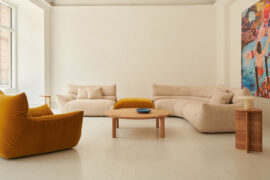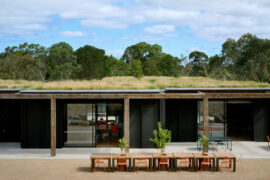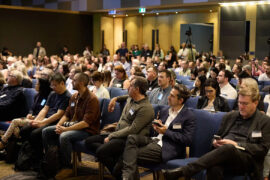FRONT.design Ambassador Neill Johanson of Davenport Campbell speaks about placemaking, ergonomics and the role of technology in informing the future of workspace design.

The workplace has evolved beyond the imagination. What was once a purely functional space has today transformed to focus on the latest in technology, collaboration and community. From cubicles that were initially the norm, people have moved on to workspaces where they can choose the most conducive settings depending on the task at hand. Today’s hybrid designs feature fluid breakout areas, huddle rooms, study nooks and conference spaces where comfort, ambience and ergonomics are a priority.
In terms of the future, Neill Johanson, principal, Davenport Campbell feels that: “The workplace of the future will support much higher levels of automation and artificial intelligence and will therefore present new opportunities for organisations to embrace change and support a creative-based economy.”
Ahead of the FRONT.design Forum on ‘Hybrid working: No man’s land or new frontier,’ we spoke with the visionary designer on his views on workspaces of the future. Register NOW, FRONT.design launches tomorrow.
Pia Sinha: When you think of the workplace of the future, what ideas come to mind?
Neill Johanson: Unlocking people’s potential, doing the most with the least and using our imagination to surprise everyone associated with the project. I spend most of my time thinking about what kind of place the new workspace should be and how it can positively influence a person’s behaviour. I’m fascinated by placemaking so I’ll often research new places such as the Lowline in New York, F Station in Paris or the Coal Drop Yards in London to understand what goes into making these highly activated places and then take those learnings and apply them to the workplace.

Do you think of the future when designing offices in the present? What might this look like for a client of Davenport Campbell?
Many of the projects we develop are years in the making because of their scale, complexity, and because the potential impact on people’s wellbeing needs to be thoroughly understood. So yes, we are always thinking about the future. The workplace of the future will support much higher levels of automation and artificial intelligence and will therefore present new opportunities for organisations to embrace change and support a creative-based economy. When considering the future, we are also doing every possible thing we can to help mitigate the causes of the climate crisis by assisting organisations to reduce their carbon footprint and ours as well.
How will our future workplaces be shaped by the changes in technology and people’s thinking and attitudes?
Technology is enabling organisations to gather vast amounts of data to maximise the use of space, and help people find each other and to facilitate virtual working. With this comes the knowledge of when, how often, and where people are working, which will represent risks to people’s privacy. Dealing with these issues will require a concerted effort. Link this data to social media accounts and the risk is compounded.
What are some of the significant changes within the workplace you have seen in the last ten years that could help us better envision and plan for what the future might hold?
That timeframe coincides with the introduction of activity-based working (ABW) in Australia, an approach to working unlike anything seen here to date. Our choices up to that point were somewhat formulaic with workplaces designed to be either highly cellular and visually hierarchical or open plan environments that promoted higher levels of visual access and a more efficient use of space. Sitting over the physical environment was up until recently, a “waterfall” working methodology that reinforced traditional linear lines of communication and workflow. In the past few years, we have seen the widespread adoption of the “agile” working methodology, which has given rise to workplaces that need to support team-based working and high levels of hackable space.

How have furniture and ergonomics changed over the last decade with the advancements in technology?
The workplace is a much more comfortable place to be these days as technology enables the furniture to adjust to a person’s anatomy and work stance automatically. More and more settings are embedded with data-gathering devices so we can tell which settings are popular and which are not. Less popular settings can be swapped out with other options by a furniture industry that has matured enormously in the past five years.
As a workplace designer, what are your views on hybrid working?
We all work differently, so it’s not unexpected that workplaces should reflect different work styles and patterns of behaviour. Most organisations also have multiple generations of people working within them with each requiring different physical settings.
Catch Neill Johanson along with Andrew Pettifer, James Calder and Leone Lorrimer at the panel seminar, Hybrid working: No man’s land or new frontier?
If you haven’t registered, now’s your last chance. REGISTER NOW and get your ticket to this fantastic panel talk.
INDESIGN is on instagram
Follow @indesignlive
A searchable and comprehensive guide for specifying leading products and their suppliers
Keep up to date with the latest and greatest from our industry BFF's!

A curated exhibition in Frederiksstaden captures the spirit of Australian design

A longstanding partnership turns a historic city into a hub for emerging talent

Davenport Campbell’s Neill Johanson shares insights from WORKTECH25 and the impact of AI on the workplace experience.

Davenport Campbell’s Anneke Alberto and Kathryn Marshall comment on the fallacy of averages in workplace design.
The internet never sleeps! Here's the stuff you might have missed

McIldowie Partners, in association with Joost Bakker, has been awarded The Learning Space at the INDE.Awards 2025. Their project, Woodleigh Regenerative Futures Studio, redefines the educational environment as a living ecosystem that nurtures sustainability, innovation, and community.

Tickets for Architecture & Design’s 2025 Sustainability Summit are on sale. This 19 November, engage in ten expert-led panels on urban planning, AI, and circular economy. Join industry leaders in Sydney or online, and gain CPD-accredited insights to drive innovative, sustainable building solutions shaping our shared future. Plus on demand access to recordings.